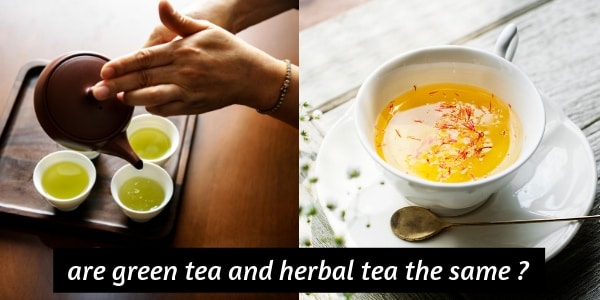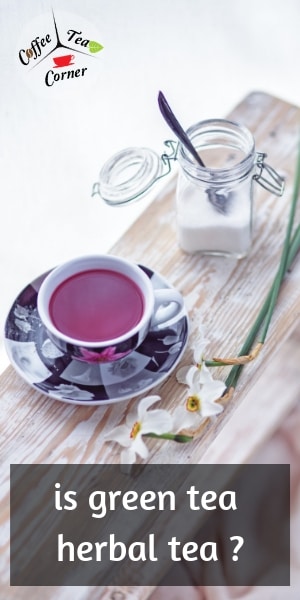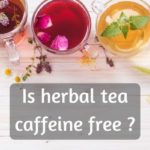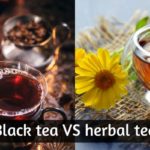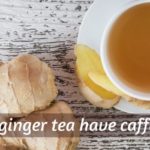Are green tea and herbal tea the same ? Often you'll find the two tea types blended together, or even a pack of tea with some green tea sprinkled into it and the box will only say herbal tea.
In a way, I guess you could argue they are the same. In the end though, they're made of very different plants. Let's check up on this in more detail.
Table of Contents
So is green tea herbal tea ?
No, actually green teas and herbal teas are very different infusions. They are both infusions, and are brewed in the same way - hot water over a certain amount of dried plants.
But their properties are very different, and historically they are not the same. Green tea comes from the Camellia sinensis plant, and is pretty much The First Tea.
Herbal teas are made of plants or flowers, like chamomile, jasmine, mint, hibiscus, and so many others. They're made mainly for flavor and healing properties.
Infusions from herbal teas are actually called tisanes, while only teas from the Camellia sinensis plant are called teas. Still, to most people (me included) they're all teas, no matter what the infusion is made of.
Now let's get a bit into what green tea and herbal teas really are, so we can understand them much better.
What is herbal tea
Herbal teas have a very long history, and were used in many forms throughout time. Witch-doctors and shamans and healers from all over regarded healing plants as helpful, and they were used for more than just that.
Over time they became popular in most houses because of the aroma they could bring, whether they were used for medicinal purposes or not.
So today we have a wide array of teas to help us in various ways. For example sage tea is wonderful for a sore throat since it helps close wounds and disinfects.
Couple it with a pine bud tea, which is great for colds and clearing out the nose and lungs, and you've got yourself one hell of a fix for a sore throat.
I used that particular mix heavily when I had tonsilitis to help reduce the symptoms. I still took the medication I needed, but that tea blend was my best friend.
Then there are teas that are just for pleasure, like for example rose petal teas, or jasmine teas. They're just so tasty and flavorful. Of course they have their own properties, but those sometimes come second when compared to taste.
Herbal teas are what most people have in their home, really. Camellia sinensis teas are an acquired taste, and many times they're blended with a herb or two in order to be more palatable for most people.
For example when I was in high school I had linden tea every night until I couldn't stand the scent. Valerian will do the same thing (calm you and lull you to sleep), but it's stronger and it smells. So. BAD.
But they all have their uses, and they're popular for those reasons.
(If you like this article so far, you can pin it to your Pinterest board by clicking the image below. The article continues after the image.)
What is green tea
Green teas are made of the leaves of the Camellia sinensis plant. The young leaves are plucked and processed in a very light way. Sometimes they are roasted very lightly (the Chinese method) and sometimes they are just steamed (the Japanese method).
Then they're dried and are good for brewing. These teas have a very green, grassy flavor and are not for everyone. Many people can't really deal with the taste of a true green tea, and they need a herb or essential oil mixed into the infusion.
To be fair, this kind of tea is an acquired taste. It's a wonderful way to boost immunity, get your fix of antioxidants, and explore the limits of your taste buds.
The health benefits are nearly endless.
Most green teas don't actually produce a green brew, partly because of how the leaves were processed, and partly because of poor brewing methods. I for one have never had a green tea that managed to brew a nice light green color.
Still, green tea remains a favorite among tea enthusiasts. On one hand it's the tradition of tea that puts green and black tea in places of honor, and on the other hand green tea just makes you feel good.
As for iced tea, which many people in Western countries absolutely adore, green tea is great for that. It's still one of the most sensitive tea types out there, right after white tea. But it's a great tea to have in your home.
You can mix and blend the two teas together
Often you will find the two tea types mixed together. It will be mostly green tea with a herb or two mixed in. Popular blends include green tea with jasmine, green tea with lemongrass, green tea with strawberry, and green tea with mint.
There are many more combinations, yes, but they're not as famous. The there are the very fruity green tea mixes. My personal favorite is a green tea with bits of mango and pineapple. It tastes just as good as you can imagine it tasting.
When it comes to green tea and herbal teas blended together, it's the fact that you get the health benefits of the green tea, mixed in with the flavor and benefits of a herbal tea, that makes the mix so great.
For example this one here is a green tea, mixed in with pineapple and ginger. The taste still lets some green tea shine through, but it's easier on people who don't much like plain green teas.
The bag steeps 50 cups of tea, so you'll have plenty to share with your friends and family if you want to.
A good green tea mixed with a few fruits or herbs will always be a good gateway into green tea territory. It's easier to handle, and if it sparks in you the love for green tea like it did for me, then you'll find a whole world of options.
In case pineapple and ginger aren't your thing, the makes of this tea have a few more green blends you can choose from.
You can check the listing on Amazon here, and read the reviews as well.
Their health benefits are different
When it comes to the health benefits of the two tea types, there are major differences.
Green tea has powerful antioxidants that help you metabolism stay young and fresh, it helps detox the body, and has a bit of caffeine for an extra kick.
The cathecins in green tea are what gives it that greenish, slightly bitter kind of taste. That's also where some of the health benefits come from.
Herbal teas are many and varied, and tracking down every single benefit they have is a very long list. Each plant that is used in a herbal tea has certain properties, and they all contribute to the overall effect of the tea.
Like the sage and pine bus tea I explained above, which helped out when my throat was closing up. Or for example the same sage tea is useful in the case of an U.T.I. and mixing it with cranberry will speed things up right away. They are a good blend.
Chamomile and wild marigold serve mainly the same purposes. They both soothe irritations and are good to reduce inflammations.
Chamomile and green tea have been long discussed, as both are very valuable teas.
Mint tea will calm down finicky bowels, and is often recommended along with plain white rice (cooked) for upset bowels.
Box thorn teas (or even just raw) are ridiculously full of vitamin C, and it's something many people stock up on before winter. Either grind them into a paste along with some honey, or brew tea out of the dried berries. They've been in my home for more than one winter now.
There are so many more health benefits than just the teas I've mentioned. But they are as many as there are leaves, plants, fruits and buds out there in the world. Wikipedia would be your best friend there. Look up a plant or two, and you'll know what their infusion would bring you.
Final thoughts
I hope I managed to clear up the confusion between green teas and herbal teas. Some people love a good herbal tea over a green tea, while others are very much annoyed by the idea.
Still. To each their own, and we all have to admit that a green tea blended with a herbal tea is always going to be a very complimenting combination. I hope you'll find your perfect cup of tea somewhere out there.
If you want to know more about coffee or tea, feel free to check the related articles below. Who knows what else you might find ?

